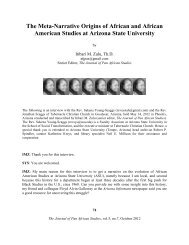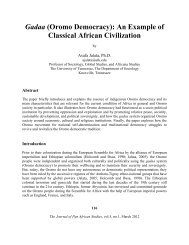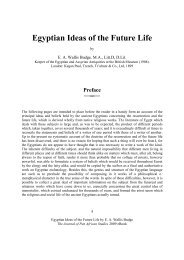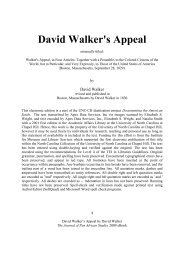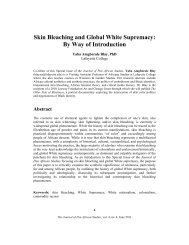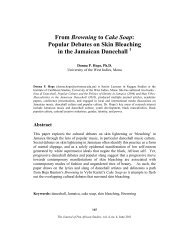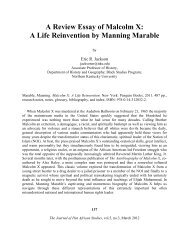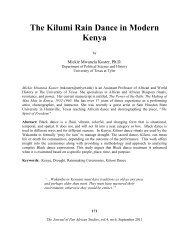view PDF - Journal of Pan African Studies
view PDF - Journal of Pan African Studies
view PDF - Journal of Pan African Studies
You also want an ePaper? Increase the reach of your titles
YUMPU automatically turns print PDFs into web optimized ePapers that Google loves.
From this assumed cultural affinity flows the unity between what is “<strong>African</strong>” and what is “<strong>Pan</strong>-<br />
<strong>African</strong>.” This paper regards both, <strong>African</strong>ist and <strong>Pan</strong>-<strong>African</strong>ist, as those aesthetic materials that<br />
consciously reference Black or <strong>African</strong> cultural values, depicting situations involving Black<br />
characters and Black history, as well as images, myths, metaphors and related aesthetic flavours<br />
that draw attention to the universalist dimension <strong>of</strong> Blackness or <strong>African</strong>ness. Such materials<br />
tend to evoke a certain similitude in cultural appreciation, and hence provoke emotions <strong>of</strong><br />
cultural affinity and ethnic solidarity, amongst persons <strong>of</strong> <strong>African</strong> descent.<br />
Features <strong>of</strong> <strong>Pan</strong>-<strong>African</strong>ism in <strong>African</strong> and Caribbean Dramas<br />
It is apt to point out from the start that the combined <strong>Pan</strong>-<strong>African</strong> <strong>of</strong>fering <strong>of</strong> <strong>African</strong> and<br />
Caribbean drama hardly approaches anywhere near the extensive reach and mass appeal <strong>of</strong> the<br />
<strong>Pan</strong>-<strong>African</strong>ist contributions made in other aesthetic fields, particularly music. For example, the<br />
reggae musicians Bob Marley and Peter Tosh <strong>of</strong> the Caribbean, as well as Fela Anikulapo Kuti<br />
and Sonny Okosuns <strong>of</strong> Nigeria, and others <strong>of</strong> their ilk, may have achieved more for the spread <strong>of</strong><br />
a <strong>Pan</strong>-<strong>African</strong> consciousness than, say, the combined effort <strong>of</strong> Caribbean dramatists such as<br />
Derek Walcott, Errol Hill and Kamau Braithwaite and <strong>African</strong> dramatists such as Wole Soyinka,<br />
Ngugi wa Thiong’o and Femi Os<strong>of</strong>isan, etc. As the Caribbean (Guyanese) politician and <strong>Pan</strong>-<br />
<strong>African</strong>ist, Eusi Kwayana, was quoted as saying, "the power <strong>of</strong> art that Bob Marley's music<br />
represented had done more to popularise the real issues <strong>of</strong> <strong>African</strong> liberation than several<br />
decades <strong>of</strong> backbrealdng work (sic) by <strong>Pan</strong> <strong>African</strong>ists and international revolutionaries” (cited<br />
in Campbell, “Rastafari as <strong>Pan</strong> <strong>African</strong>ism” 76). To this one may also add: decades <strong>of</strong><br />
backbreaking work by <strong>Pan</strong>-<strong>African</strong>ist playwrights.<br />
The comparison is an unfair one, since music, in its unbridled appropriation <strong>of</strong> the air waves, has<br />
an obviously wider reach than drama, or any other genre <strong>of</strong> aesthetics for that matter. More<br />
crucially, however, the works <strong>of</strong> the musicians tend to contain more explicit references to <strong>Pan</strong>-<br />
<strong>African</strong>ism than may be extracted from works <strong>of</strong> drama. The magical lyrics <strong>of</strong> the <strong>Pan</strong>-<strong>African</strong>ist<br />
reggae singers (e.g. the Caribbean Marley’s: “How good and how pleasant it would be before<br />
God and man, yea-eah! /To see the unification <strong>of</strong> all <strong>African</strong>s, yeah!” in his song, “Africa Unite,”<br />
or the Nigerian Okosun’s “<strong>African</strong>s Unite/No matter where you may live/No matter the language<br />
you speak/ …” also in his Africa Unite) resonates with direct references to <strong>Pan</strong>-<strong>African</strong>ism<br />
beyond what would be found in any <strong>of</strong> the comparatively obscure lines <strong>of</strong> the Caribbean and<br />
<strong>African</strong> dramatists. Because <strong>of</strong> its relative short length and intensity, musical expressions<br />
maintain a focus on the subject matter without the distraction <strong>of</strong> space, time, suspense and<br />
narrative development, which are the hallmarks <strong>of</strong> drama. However, what the latter lacks in mass<br />
appeal it makes up for in textual density and intellectually challenging aesthetic complexity.<br />
Drama in particular allows a condensation <strong>of</strong> various aesthetic usages and materials from<br />
multiple sources to service the ideologies and thematic thrusts <strong>of</strong> the dramatist. The focus in this<br />
paper is on history and myth, among fodder materials frequently deployed for the rendition <strong>of</strong><br />
<strong>Pan</strong>-<strong>African</strong> sensibilities in <strong>African</strong> and Caribbean theatres.<br />
193<br />
The <strong>Journal</strong> <strong>of</strong> <strong>Pan</strong> <strong>African</strong> <strong>Studies</strong>, vol.5, no.8, December 2012



